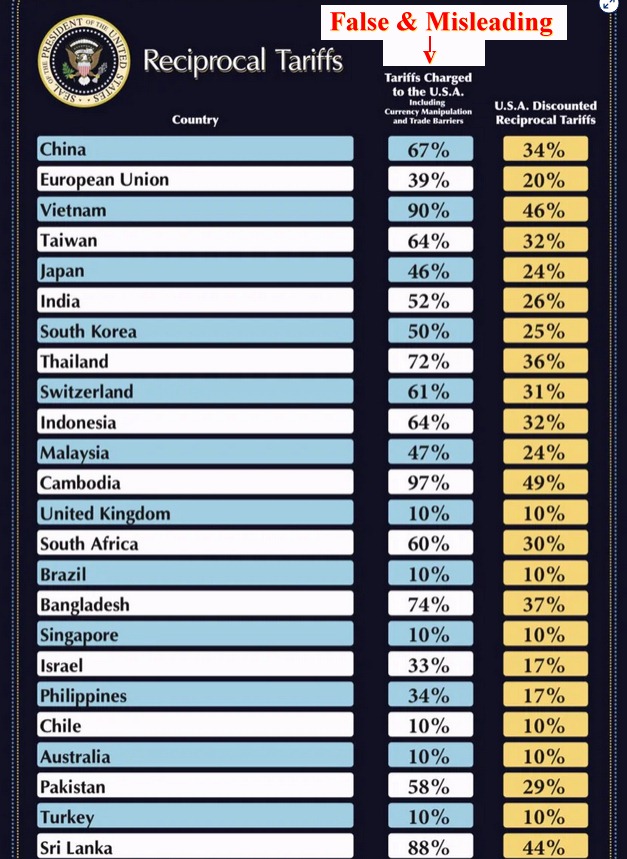by Daniel Brouse
April 5, 2025
The tariffs announced on what Trump dubbed “Liberation Day” featured a chart titled Tariffs Charged to the U.S.A., purporting to show the crushing rates foreign countries supposedly impose on American goods. But these numbers were completely fabricated — not grounded in trade data or economic principles. Instead, Trump’s team appears to have confused tariffs with trade deficits, using the size of the U.S. trade deficit with each country to create a fictional “tariff rate.”
This fundamental misunderstanding is emblematic of much of Trump’s economic worldview — one that runs counter to decades of established economic theory.
In reality, U.S. trade deficits have long benefited American consumers by allowing access to cheaper foreign goods, while the strength of the dollar fuels domestic spending. The U.S. essentially trades inexpensive paper money for real goods — raw materials, finished products, and even luxury items — while foreign countries often recycle those dollars back into U.S. Treasuries, helping finance America’s debt.
Yet Trump continues to argue that trade deficits equal theft.
Trump’s Trade Narrative: Economic Victimhood
In speeches and social media posts in April 2025, Trump has claimed:
“For too long, corrupt foreign leaders — even from the poorest countries — have slapped massive tariffs on American products while flooding our markets with their goods, often duty-free. It’s been a one-sided scam — they’ve taken our jobs, stolen our industries, and destroyed entire American communities.”
Trump alleges that:
-
Foreign tariffs make U.S. farmers and manufacturers uncompetitive.
-
The U.S. has been the “piggy bank” of the world.
-
New tariffs will “level the playing field” and force “fair deals.”
Supporters call this economic justice. Critics call it economic vandalism. Wall Street has already rebranded “Liberation Day” as The Big Mistake.
Lesotho: Targeting One of the World’s Poorest Nations
Among the most striking examples of Trump’s tariff policy is Lesotho — a tiny, landlocked kingdom in southern Africa and one of the poorest nations in the world. The U.S. has imposed a staggering 50% tariff on its exports — the highest tariff applied to any sovereign country.
Lesotho’s economy depends heavily on textiles exported under the African Growth and Opportunity Act (AGOA), and diamond exports to the U.S. are another vital revenue source. In 2024, Lesotho exported about $237 million in goods to the U.S.
The 50% tariff threatens to devastate Lesotho’s fragile economy, potentially wiping out thousands of jobs in a country where nearly half the population already lives below the poverty line.
Tariffs on Penguins: Heard and McDonald Islands
In perhaps the most surreal example of Trump’s trade war, a 10% tariff was imposed on the Heard and McDonald Islands — an uninhabited Australian territory in the sub-Antarctic populated only by penguins and seals.
With no human population and no meaningful exports, the islands became a global punchline. Memes exploded online mocking Trump’s “penguin tariff” as the ultimate symbol of policy absurdity.
Economic Isolation — and Global Backlash
Trump’s tariff strategy has triggered a wave of retaliatory measures, trade disruptions, and diplomatic backlash. Analysts warn that the U.S. is rapidly isolating itself from global supply chains, allies, and markets.
The economic damage has been swift and severe — not just abroad but at home, as higher consumer prices, supply shortages, and market instability ripple through the U.S. economy.
As one critic put it:
“Trump didn’t just pick a trade war — he picked one with the entire planet.”
RESOURCES:
China Hits Back: 84% Tariff Targets U.S. Farmers First
Protectionism 101: Trump Economics
- Trumpenomics: How Tariffs, Policy Cuts, and Labor Shortages Are Devastating American Farmers
- The Devastating Impact of Trump’s Steel and Aluminum Tariffs
- Tariffs: The Most Regressive Tax That Hurts the Economy Without Reducing the Deficit
- World Economics 101: The United States and Global Trade Dynamics
- The Lies Behind Trump’s Terror Economics
- A Storm Brewing in Global Trade
- The Economic and Diplomatic Consequences of Trump’s Tariff Expansion
- The Hidden Costs of Short-Term Gains: Inflation, Tariffs, and Fiscal Recklessness
- How Tariffs on Guitars and Pianos Could Impact the Next Generation of Musicians
- Liberation (From Your Money) Day: Largest Tax Increase in History
- Trump’s Sector-Specific Tariffs
- Trade War!
On April 2, President Trump unilaterally declared a trade war against the rest of the world, imposing protectionist tariffs on 180 countries — calling it “Liberation Day.” This action was taken without congressional approval and in direct violation of the Constitution.
